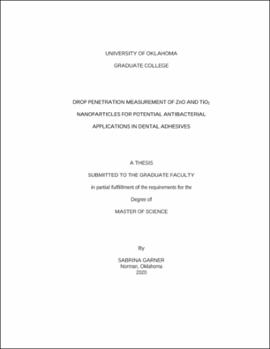| dc.description.abstract | Despite all efforts carious lesions continues to be a significant problem in dentistry. Secondary caries is a biofilm-originated disease that typically occurs at the tooth-adhesive resin interface. According to previous studies, secondary caries is the most common cause of failure of polymer-based bonded restorations. To help reduce the formation of secondary caries, the biofilm forming between the tooth structure (enamel and dentin) and the adhesive resin needs to be prevented. Some studies have shown the ability of metal oxides to have antimicrobial properties. Amine oxides have also shown antibacterial characteristics. Based on this context, the effectiveness of zinc oxide nanoparticles and amine oxides in dental adhesive resins as non-leaching long-term antibacterial agents to prevent biofilm formation is examined in this study.
When altering the composition of commercially available dental adhesive resins either by incorporating antibacterial agents (e.g., chlorhexidine, antibiotics, fluoride) or nanoparticles, it is important to extensively characterize the mechanical, chemical, and biological properties of experimental materials to determine their potential clinical utilization. In addition, it is important to fully characterize the nanoparticles of choice to tailor the interfacial chemistry between nanoparticles and the polymer and functionalize the nanoparticles to achieve optimum biological performance. In the present study, the wettability of different solvents (distilled water, diiodomethane, bromonaphthalene, formamide, ethanol and ethylene glycol) on zinc oxide nanoparticles (NanogardTM and NanoTekTM) and that of water on experimental dental adhesive resins was investigated to determine the surface properties of nanoparticles and experimental dental adhesive resins. Results reported in the present study may help to determine the effects of the incorporation of nanoparticles and surfactants on the ability of OptiBond Solo Plus (Kerr Corp. USA), which is a fifth generation dental adhesive resins, to efficiently establish the hybrid layer between the tooth structure and the composite resin.
In Chapter 2, a modified drop penetration method is described and was employed to reveal some surface properties of nanoparticles investigated, such as wettability and surface energy components of nanoparticles before their incorporation into dental adhesive resins. Six solvents (water, diiodomethane, bromonaphthalene, formamide, ethanol and ethylene glycol) were examined for two nanoparticle substrates, zinc oxide and titanium dioxide, with the goal of assessing the suitability of a modified drop penetration method (DPM) for orders of magnitude smaller particles. Specimens composed solely of nanoparticles (either zinc oxide or titanium dioxide) were compressed into flat discs using a manual press. Solvents were then individually dispensed, using a computer-controlled syringe, onto the surfaces of individual specimens (3 drops/specimen) while the shape and volume of droplets were recorded using digital images (at 25 frames/second) for 1 minute in the experimental chamber of a contact goniometer (at room temperature). Contact angles were then calculated (ranges between 20–80°) and were demonstrated to be in reasonable agreement with previous reports in the literature, but failed to provide acceptable results for surface energy components. Because of that, it was necessary to eliminate certain solvents and substrates that did not meet the inclusion criteria described in Chapter 2.
In Chapter 3, the nanoparticles and amine oxide surfactant were incorporated into commercially available dental adhesive resins. A series of tests are described to determine water wettability properties of experimental materials and their antibacterial properties against Streptococcus mutans, which is a well-known caries-producing microorganisms and has been used as a model organism in numerous studies. The contact angles (initial and final) of adhesives with and without the incorporation of nanoparticles and surfactants was determined using the Laplace-Young equation to reveal the effects of nanoparticles and surfactants on their surface properties. Results reported are anticipated to positively influence subsequent studies in the field of dental biomaterials and materials sciences because it provides fundamental information regarding how surface properties may impact the service lives of materials investigated. The incorporation of nanoparticles and surfactants were shown to alter the typical wettability behavior of commercially available dental adhesive resins and experimental materials were observed to display higher contact angles (both initial and final) and therefore were considered more hydrophobic. A similar behavior could not be observed when the commercial adhesive resins was altered by the incorporation of investigated surfactants. In this instance, experimental materials were observed to display lower contact angles when compared to their commercially available counter parts and, therefore, were considered more hydrophilic. A minimally invasive and real-time bioluminescence assay was employed to determine the metabolic status of S. mutans to determine the antibacterial properties of experimental materials following previously published protocols. Results attained demonstrated that experimental materials investigated (containing either nanoparticles or surfactants) did not decrease the metabolic activity of S. mutans when compared to the metabolic status observed in biofilms grown against commercially available dental adhesive resins. Because of that, it was decided to conduct a minimum bactericidal concentration test (MBC) where nanoparticles investigated (either zinc oxide or titanium dioxide) were suspended directly in planktonic cultures of S. mutans. The objective of this experiment was to increase the exposure of microorganisms to nanoparticles investigated and to demonstrate any potential antibacterial effect from the nanoparticles against S. mutans. After being exposed to nanoparticles, the viability of S. mutans was determined using the colony forming unit assay (CFU/mL) by plating the microorganisms into agar plates supplemented with yeast extract and spectinomycin. Results reported have indicated that zinc oxide nanoparticles (either coated or uncoated) were not capable of inhibiting S. mutans in the conditions tested as denoted by agar plates displaying viable colonies in all dilutions (100 to 10-9). An opposite behavior was observed when microorganisms were exposed to the surfactant. In this case, S. mutans were shown to be inhibited in all dilutions investigated, thereby displaying a strong antibacterial effect. Taken together, results reported indicate that nanoparticles did not show any type of antibacterial behavior when in suspension or when immobilized in a commercially available dental adhesive resin. | en_US |
